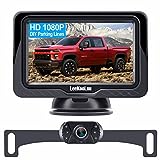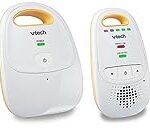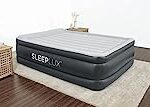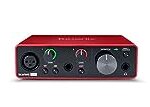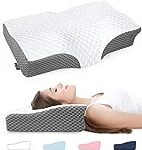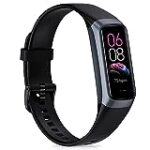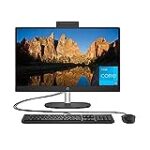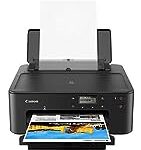🌅 Introduction
Welcome to our comprehensive backup cameras buying guide! Whether you’re a seasoned driver or a newbie behind the wheel, backup cameras have become an essential safety feature for all vehicles. With the increasing number of accidents caused by reversing, it’s crucial to invest in a reliable and high-quality backup camera system. In this guide, we will walk you through the key factors to consider when purchasing a backup camera, including resolution, field of view, night vision capabilities, and installation options. So, let’s dive in and find the perfect backup camera that suits your needs and ensures a stress-free and secure driving experience.
🏆 Our Top 5
- Easy to Install: The backup camera for car takes only 15 minutes from start to finish installation, just 2 steps: ① First connect backup camera and monitor through the 4-pin video power cable made of 3.0MM pure copper. ② Then plug the reverse camera system into the cigarette lighter or USB plug (not included), manual switch, plug and play. Or you can also connect it to the reversing lights only as a reversing use, automatically triggering the reversing image when reversing.
- Stable Signal Transmission: The wired rear view camera has more stable transmission and will not lose signal at any time. If your wireless backup camera is always intermittent and delayed, a wired backup camera is a reliable companion for every drive. The car backup camera is widely used on car, truck, pickup, SUV, minivan, sedan, MPV, Hatchback,Wagon and other vehicles.
- HD 1080P Crystal-clear Image: With more advanced CIS image sensor and continuous optical zoom technology, back up camera systems for truck improves picture imaging clarity by 80% than other vehicle backup cameras. The car rearview camera has 7 built-in white LEDs, anti-halo chip and 650 filter chip, which will automatically switch to night vision function according to the intensity of the light, providing HD 1080P resolution color images both day and night to ensure your driving safer.
- Durable Reverse Camera: Backup camera for truck is sealed to prevent dust and rain from entering and meets IP69K waterproof standard, so it can work normally even in bad weather and provide stable image. The camera housing is made of ABS material with good impact resistance,which can absorb and disperse the impact force to protect internal components when it is hit. And it can withstand various conditions,such as temperature changes,UV radiation,etc., which is suitable for long-term outdoor use.
- 4.3 Inch Display Multiple Placement: Equipped with a powerful suction cup mount, backup camera with monitor can provide great stability for this screen,not vibrate or shake. You can place the monitor on the windshield,or dashboard. Using IPS screen will make images are rendered with greater clarity and finesse, which maintains image consistency from various directions, making your eyes more comfortable.
- 【Plug and Play】The backup camera for car takes only 15 minutes from start to finish installation, just 2 steps: ① First connect the camera and monitor through the 4-pin video power cable made of 3.0MM pure copper that comes with the camera. ② Then plug the reverse camera system into the cigarette lighter or USB plug (not included), manual switch, plug and play. Or you can also connect it to the reversing lights only as a reversing use, automatically triggering the reversing image when reversing.
- 【Stable Signal Transmission】 The wired backup camera kit is superior in signal stability compared to the wireless backup camera. The backup camera for truck will automatically minimize energy loss during transmission, not only will there be no signal delays, interference, fluctuations or intermittent problems, but also realize the transmission of real-time data, providing you with HD 1080P color images at all times, to ensure safer driving.
- 【100% Waterproof】The back up camera for cars housing is made of ABS-TC material and also utilizes the latest nano-coating sealing technology with IP69 level waterproof performance, which is able to work perfectly and provide clear images in extreme environments from -22°F to 176°F. This back up camera is like a brave guardian, not eroded by any water or fine particles, tenaciously resisting the baptism of wind/rain/dust/high and low temperatures, enhancing the safety index and service life.
- 【Ultra HD Picture Quality & Night Vision】The truck backup camera adopts advanced optical anti-shaking technology with SC1346 color image sensor chip to avoid the problem of shaky and blurred images when driving on bumpy roads. The rear view camera has 6 built-in white LEDs, anti-halo chip and 650 filter chip, which will automatically switch to night vision function according to the intensity of the light, providing HD 1080P resolution color images both day and night to ensure your driving safer.
- 【Latest Design】The car backup camera housing is made of ABS+PC metal raw material with 4.3 inch LCD display, easier to use than 7 inch and 5 inch, image is more focused and clearer, the weight won't look bulky and won't block the driver's view in front. The reverse camera for car suction cup bracket is made of ABS+TPU material, 360° rotating design, more stable than normal bracket to mount the display on dashboard or windshield, won't melt and fall off even after long time use and sunlight.
- 【Ultra HD Screen & Accurate Color】The backup camera is designed to eliminate blind spots and avoid obstacles when reversing. 680P Ultra HD picture shows a clear image for the driver. No more annoying blurry discoloration screen and picture, and displays the most ideal road condition.
- 【12 LED & Superior Night Version】12 LED super bright lights illuminates the images when daylight is low, and greatly enhances night vision with sharp images. The sensor will turn on the light automatically when you activate the reverse gear, which gives you the best view for parking.
- 【IP68 Waterproof & 140° View Adjustable Angle】The camera will be protected from powerful jets of water from any direction, such as rain and a car wash. Works well in extreme weather. Adjustable vertical 140° perfect viewing angle, which allows you to adjust the camera to a position that’s best for you, effectively reducing the accident rate.
- 【2 in1 Installation & Tools Included】Camera can be installed on license plate frame, or mounted on back, front, and side based on your preference. The camera or its mounting bracket will not take a lot of space on your license plate. Suitable for most 12V-24V vehicles, such as Jeeps, SUV, RV, VAN, etc.
- 【Best Customer Service】INCLAKE backup camera is guaranteed to provide a safe road trip.Feel free to contact us if you have any issues with the item.
- Crystal-clear 2K Image: Our backup camera for trucks provides a clear 2K image that makes reversing easy and safe. The vehicle backup camera bracket can be hidden under the license plate, giving your vehicle an even sleeker look and doesn't obscure the number plate.
- Easy Installation: Equipped with a USB power cord that plugs directly into your truck backup camera for quick and easy installation. You can have the reversing camera up and running immediately. Avoid the hassle of not having a cigarette lighter in your vehicle.
- Great Night Vision: Back up camera systems for car boasts excellent night vision. You'll be able to see obstacles at night as clearly as during the day.
- Dependable Signal Transmission: Back camera for car reverse system offers reliable and stable signal transmission for your truck, giving you peace of mind when driving and parking.
- Adjustable Guidelines: Our rear view camera for car parking line can be easily adjusted to fit your needs. You can move it left, right, up or down to fit your real condition and turn it off if you prefer.
- ►【Easy Installation in 8 Mins】The waterproof camera and HD monitor are powered by one power supply, No need to power the camera and monitor separately, just connect the monitor to a cigarette lighter adapter/Acc/fuse etc, then wire the camera and monitor. Plug and Play - Much less installation effort than wireless rear camera systems.
- ►【Wired Back up Camera, Stable Signal Transmission】The wired reversing camera kit has more stable transmission and will not lose signal at any time. If your wireless backup camera is always intermittent and delayed, a wired camera is a reliable companion for every drive. The rv backup camera connects directly to the monitor via a 66ft cable and is widely used on trailer, truck, tractor, bus, rv, van, suv and more.
- ►【Clear Night Vision & 150° Non-fisheye distortion camera】True IR night vision greatly enhances the image, and the back up camera works even with minimal light around, allowing you to identify objects in the dark. 150 Degree Wide Viewing Angle - Non-fisheye distortion camera, great for lane changing and nighttime backing up and parking in narrow alleys.
- ►【7 inch IPS HD Monitor & Anti-Glare Sunshade】The 7" IPS display offers clearer and more vibrant color images, along with a wider viewing angle that maintains image consistency from various directions. Compare other screens, it reduces glare and flicker during long drives, making it easier on the eyes. Additionally, the backup camera for truck includes a sunshade for improved visibility in strong sunlight.
- ►【"Real Neck Saver" with Parking Guidelines and Image Flip】Reliable parking lines and image flip for fast and perfect reversing without having to turn around all the time, no more neck pain. Even if you sometimes have trouble figuring out the steering, just switch to the "mirror" view on the monitor, making you at ease when reversing.
🤔 How to choose?
1. Resolution: Choosing the Right Image Quality
When it comes to backup cameras, one of the most important factors to consider is the resolution of the camera. The resolution determines the image quality and clarity, allowing you to see objects and obstacles clearly.
A higher resolution camera will provide a sharper and more detailed image, making it easier to identify objects and judge distances accurately. On the other hand, a lower resolution camera may result in a blurry or pixelated image, making it difficult to see small details.
When choosing a backup camera, look for a resolution of at least 720p or higher for optimal image quality. This will ensure that you have a clear view of your surroundings and can navigate safely.
2. Field of View: Expanding Your Vision
The field of view is another crucial aspect to consider when selecting a backup camera. It determines how much of the area behind your vehicle the camera can capture. A wider field of view allows you to see more of your surroundings, reducing blind spots and increasing safety.
Aim for a backup camera with a field of view of at least 120 degrees or more. This will provide a wide-angle view, giving you a comprehensive picture of what’s happening behind your vehicle.
Remember, a wider field of view doesn’t necessarily mean better image quality. It’s important to strike a balance between a wide field of view and high resolution for the best overall performance.
3. Night Vision: Seeing Clearly in the Dark
Driving at night or in low-light conditions can be challenging, especially when it comes to using a backup camera. That’s why it’s essential to choose a camera with good night vision capabilities.
Look for a backup camera that features infrared (IR) LEDs or other night vision technology. These LEDs illuminate the area behind your vehicle, allowing the camera to capture clear images even in complete darkness.
Having a backup camera with reliable night vision can greatly enhance your safety and prevent accidents when backing up in poorly lit areas.
4. Mounting Options: Finding the Right Fit
Backup cameras come in various mounting options, and it’s important to choose one that suits your vehicle and preferences.
Some cameras are designed to be mounted on the license plate, while others can be installed on the rear bumper or even integrated into the tailgate handle.
Consider the layout of your vehicle and the available mounting options before making a decision.
Additionally, if you’re not comfortable with DIY installations, you may want to opt for a wireless backup camera that doesn’t require complex wiring.
5. Additional Features: Enhancing Your Experience
Backup cameras often come with additional features that can enhance your overall experience and safety. Some of these features include parking guidelines, motion detection, and even built-in DVR capabilities.
Parking guidelines can be particularly useful, as they provide visual cues to help you park accurately and avoid obstacles. Motion detection can alert you to any movement behind your vehicle, ensuring that you’re aware of any potential hazards.
Consider your specific needs and preferences when choosing a backup camera, and look for additional features that align with those requirements.
Remember, the goal is to find a backup camera that not only meets your basic needs but also enhances your driving experience and keeps you safe on the road.
💡 What to Look for in a backup cameras?
1. Image Quality
When it comes to backup cameras, image quality is of utmost importance. After all, the whole purpose of installing a backup camera is to enhance your visibility and ensure safety while reversing your vehicle. Look for a camera that offers high-resolution imaging, preferably with at least 720p or higher. This will provide you with a clear and detailed view of what’s behind you, allowing you to spot any potential obstacles or hazards.
2. Field of View
The field of view is another crucial factor to consider when choosing a backup camera. A wider field of view means you’ll be able to see more of your surroundings, reducing the chances of missing any blind spots. Look for a camera with a field of view of at least 120 degrees or more. This will provide you with a broader perspective, making it easier to maneuver your vehicle in tight spaces or crowded parking lots.
3. Night Vision
Driving at night can be challenging, especially when it comes to reversing your vehicle. That’s why it’s essential to choose a backup camera with excellent night vision capabilities. Look for a camera that utilizes infrared technology or has built-in LED lights to illuminate the area behind your vehicle in low-light conditions. This will ensure that you have a clear view of your surroundings, even in the darkest of nights.
4. Waterproof and Durable
Since backup cameras are typically mounted on the rear of your vehicle, they are exposed to various weather conditions and potential damage. Therefore, it’s crucial to choose a camera that is waterproof and durable. Look for cameras with an IP67 or higher rating, as this indicates that they are dustproof and can withstand immersion in water up to a certain depth. Additionally, opt for cameras with sturdy construction and shockproof features to ensure they can withstand any bumps or vibrations while driving.
5. Easy Installation
Lastly, consider the ease of installation when choosing a backup camera. Look for cameras that come with clear instructions and all the necessary mounting hardware. Wireless cameras are often easier to install as they eliminate the need for running cables through your vehicle. However, if you prefer a wired camera, ensure that the cables are long enough to reach your display unit without any hassle.
By considering these factors – image quality, field of view, night vision, waterproof and durability, and easy installation – you can make an informed decision when purchasing a backup camera that meets your specific needs and enhances your driving experience. Remember, safety should always be a top priority, and a reliable backup camera can significantly contribute to it.
🔍 How we picked?
1. Researching the Latest Technology
When it comes to choosing the best backup camera for your vehicle, it’s essential to stay up-to-date with the latest technology. We understand that technology is constantly evolving, and we want to ensure that our readers have access to the most advanced and reliable backup cameras on the market.
To accomplish this, our team of experts spends countless hours researching and testing the latest models from various manufacturers. We analyze features such as resolution, field of view, night vision capabilities, and wireless connectivity options. By staying on top of the latest advancements, we can provide our readers with accurate and comprehensive information to help them make an informed decision.
For example, one of the latest technologies we’ve come across is the use of high-definition cameras with wide-angle lenses. These cameras provide a crystal-clear view of the area behind your vehicle, allowing you to see obstacles and potential hazards with greater clarity. This technology is particularly useful for larger vehicles, such as trucks or RVs, where blind spots can be a significant concern.
2. Considering User Reviews and Feedback
While our team of experts thoroughly tests each backup camera, we also understand the importance of considering user reviews and feedback. After all, who better to provide insight into a product’s performance than those who have already purchased and used it?
We carefully analyze user reviews from various sources, including online retailers and automotive forums, to gain a better understanding of the strengths and weaknesses of each backup camera. This feedback helps us identify any potential issues or limitations that may not have been apparent during our testing process.
For instance, we recently came across a backup camera that received rave reviews for its ease of installation and user-friendly interface. However, upon further investigation, we discovered that some users experienced connectivity issues with the wireless transmitter, resulting in intermittent signal loss. This feedback allowed us to provide a balanced review, highlighting both the camera’s positive aspects and potential drawbacks.
3. Considering Price and Value
We understand that price is an important factor for many consumers when purchasing a backup camera. That’s why we carefully consider the price and value of each camera we review.
Our goal is to find backup cameras that offer the best combination of features, performance, and affordability. We believe that a backup camera should provide excellent value for money, regardless of the price range. Whether you’re on a tight budget or willing to invest in a high-end model, we strive to recommend cameras that offer the most bang for your buck.
For example, we recently reviewed a budget-friendly backup camera that exceeded our expectations in terms of performance and reliability. Despite its affordable price, this camera offered a wide field of view, excellent night vision capabilities, and easy installation. It proved that you don’t always have to break the bank to get a quality backup camera.
💬 Frequently asked questions about backup cameras
1. What is a backup camera and why do I need one?
A backup camera, also known as a rearview camera, is a device that is mounted on the rear of a vehicle to provide a clear view of the area behind the vehicle. It is designed to help drivers avoid accidents and collisions while reversing or parking.
Having a backup camera installed in your vehicle can greatly enhance your safety and peace of mind. According to the National Highway Traffic Safety Administration (NHTSA), backup cameras can help prevent accidents and save lives. In fact, the NHTSA estimates that backup cameras could prevent up to 95% of all backing accidents if every vehicle had one installed.
2. How does a backup camera work?
A backup camera works by capturing video footage of the area behind the vehicle and displaying it on a screen inside the vehicle. The camera is usually mounted on the rear bumper or license plate, and it is connected to a monitor or display unit on the dashboard. When the driver engages the reverse gear, the camera is activated and provides a live feed of the rear view.
The camera uses a wide-angle lens to capture a broad view of the surroundings, allowing the driver to see obstacles, pedestrians, or other vehicles that may be in the blind spot. Some advanced backup cameras even have features like night vision, parking guidelines, and object detection to further enhance safety.
3. Are backup cameras difficult to install?
Installing a backup camera can vary in difficulty depending on the make and model of your vehicle and the type of camera you choose. However, many backup cameras are designed to be user-friendly and can be easily installed by following the provided instructions.
If you are not comfortable with DIY installations, it is recommended to seek professional help to ensure proper installation and functionality. A professional installer can also provide valuable advice on the best placement for the camera and ensure that it is aligned correctly for optimal performance.
4. Can I use a backup camera on any vehicle?
Backup cameras can be installed on most vehicles, including cars, trucks, SUVs, and RVs. However, it is important to consider the compatibility of the camera with your specific vehicle model. Some vehicles may require additional wiring or adapters to connect the camera to the existing display unit.
Before purchasing a backup camera, it is advisable to check the compatibility with your vehicle and consult the manufacturer’s guidelines or seek professional advice if needed.
5. Are wireless backup cameras better than wired ones?
Both wireless and wired backup cameras have their advantages and disadvantages. Wired backup cameras generally provide a more stable and reliable connection, as they are directly connected to the display unit through a cable. They are less prone to interference and offer a higher quality video feed.
On the other hand, wireless backup cameras are easier to install as they eliminate the need for running cables through the vehicle. They are also more versatile and can be easily transferred between vehicles. However, they may be susceptible to signal interference and the video quality may be slightly lower compared to wired cameras.
Ultimately, the choice between wireless and wired backup cameras depends on your specific needs and preferences.
Last update on 2024-05-05 / Affiliate links / Images from Amazon Product Advertising API
